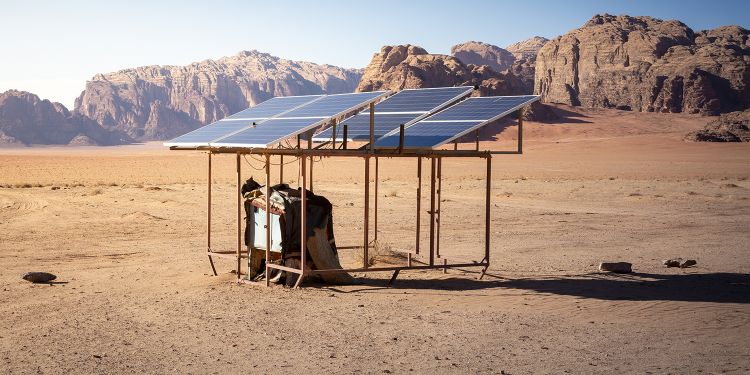BiGS Actionable Intelligence: As solar power networks expand to potentially deliver electricity to more than 1 billion people living outside traditional grids, questions persist about how energy production and energy storage technologies can best be integrated to ensure a profitable yet low-cost energy supply. Recent research led by a Harvard Business School professor sheds new light on possible solutions.
BOSTON–Millions of households and businesses around the world aren’t served by national electricity grids and instead must rely on expensive, high-carbon diesel power generation, if any exists. However, new research led by a Harvard Business School (HBS) professor reveals a solution: an innovative approach that helps investors make better decisions about remote renewable energy networks, potentially increasing profitability and improving the delivery of reliable energy supply.
The new approach involves using a mix of solar energy and energy storage technologies to replace some diesel generation and increase electricity access. This is timely because tens of billions of dollars in new investment is planned or underway to deliver hybrid solar power to off-grid communities in remote regions across Africa, Europe, and the Americas.
This new approach requires “an evidence-based model to determine the right mix of technologies,” Christian Kaps, an HBS assistant professor who has researched renewable electricity generation and storage for six years, told Harvard Business School’s The BiGS Fix. This model is precisely what Kaps and his fellow researchers explore in their paper published last year in Management Science.
Billions Slated To Be Spent on Off-Grid Power
The global mini-grid market consists of more than 50,000 installed and planned grids in more than 130 countries, according to the Energy Sector Management Assistance Program at the World Bank. Of that market, nearly 30,000 mini-grids are planned for development in 77 countries and territories in the next few years, of which 99 percent will be powered by solar. The UN Sustainable Development Goals (SDGs) call for achieving universal power access by 2030.
In their Management Science paper, Kaps and co-authors Simone Marinesi and Serguei Netessine explore the mix of power generation and power storage used in communities that lie outside national electricity grids. When the primary renewable energy source stops generating electricity after dark, hybrid sources of power generation are intended to keep the lights on around the clock. These hybrids combine renewable solar power with storage capacity or fossil fuel backup.
Finding a Market-Driven Mix
“The big question with the green energy transition is how much of it is market-driven,” Kaps told The BiGS Fix. He and his colleagues set out to understand how different energy production and storage technologies work together, and under which circumstances they should be combined to assure a consistent, low-cost supply of energy.
The new findings offer a starting point for investors where off-grid power networks are under consideration: an approach that allows them to quickly explore a variety of storage technologies and cost scenarios.
Recently, solar power mini-grids have been rolled out to replace diesel—especially in West Africa and remote areas of high-income economies—or to provide power for infrastructure or mining projects. However, the initial experience with solar-based mini-grids was mixed due to the unreliability of production and limited storage capacity.
Big private energy developers—including Tata Power Renewable Mini-Grids in India and Husk Power in India and Africa—with the support of global development institutions, use a multi-faceted approach to achieving the universal power access called for by the SDGs. These include scaling mini-grids using a mix of solar, wind, diesel, and storage.
As of 2022, about $37 billion in new investment was planned, according to the World Bank’s Energy Sector Management Assistance Program. Several times that amount would be required to reach all areas of the world with people not currently served by existing grid power sources.
Kaps notes that the new model outlined in his paper also is relevant for large investment projects located outside major populations centers that require power, including those in more developed economies.
Unexpected Findings on Storage
The article, When Should the Off-Grid Sun Shine at Night? Optimum Renewable Generation and Energy Storage Investments, explores how to determine the optimal mix for generating reliable power, both profitably and at low cost. For instance, the article finds that solar power and storage capacity are strategic complements when both power and storage capacities are low. However, when there is a large amount of either solar power or storage capacities, the two technologies can become strategic substitutes that affect long-term investment decisions.
The authors also made a counterintuitive finding regarding storage capacity, where at first glance, high-efficiency but expensive lithium-ion batteries would be expected to offer the best power storage solution. Kaps and colleagues found that given the current conditions, lower-efficiency, cheaper technologies such as thermal storage capacity can more easily turn a profit in off-grid applications than lithium-ion batteries can.
HBS Emphasis: Business and Climate Change
The article was selected to be part of a special section focused on Business and Climate Change of the academic journal Management Science. The section was edited by HBS professors Mike Toffel and George Serafeim, both pioneers in exploring the role of business, investments, and supply chains in the era of climate change.
“We asked how we can increase engagement in business and climate change research,” said Toffel, regarding the project that was conceived about five years ago and evolved into the Management Science special section. The final selection of 23 articles, published in December 2023, were chosen from among scores of submissions from faculty and researchers across a range of universities and business disciplines.
Kaps’ research was carried out and completed during his doctoral work at the University of Pennsylvania’s Wharton School. He recently brought his expertise to HBS, where he joined the faculty in this past semester.

